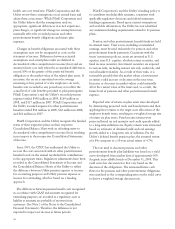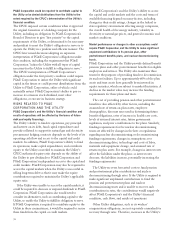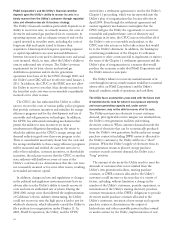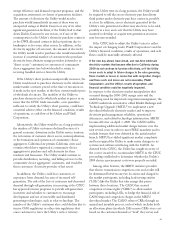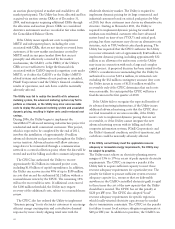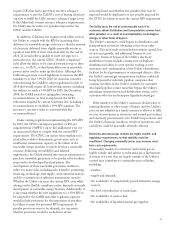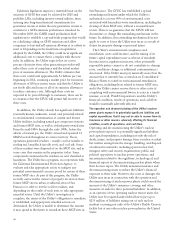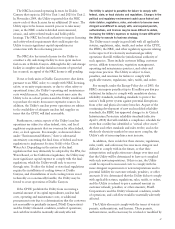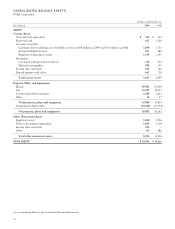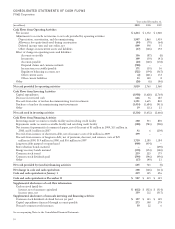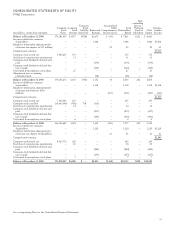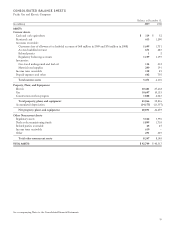PG&E 2009 Annual Report Download - page 49
Download and view the complete annual report
Please find page 49 of the 2009 PG&E annual report below. You can navigate through the pages in the report by either clicking on the pages listed below, or by using the keyword search tool below to find specific information within the annual report.In 2008, the Utility undertook a thorough review of its
operating practices and procedures used in its natural gas
system, including its gas leak survey practices. The Utility
determined that improvements needed to be made to
operating practices and procedures, including increasing
the accuracy of gas maintenance records and compliance
with operating procedures. During 2009, the Utility
incurred costs of approximately $100 million to accelerate
the work associated with systemwide gas leak surveys. The
accelerated work is scheduled to be completed in April
2010. Throughout this time, the CPUC’s Consumer
Protection and Safety Division (“CPSD”) has been
conducting an informal investigation of the Utility’s
natural gas distribution maintenance practices. The Utility
has provided information to the CPSD about the Utility’s
review and the remedial steps the Utility has taken. PG&E
Corporation’s and the Utility’s financial condition, results
of operations, and cash flows would be materially adversely
affected if the Utility were to incur material costs or other
material liabilities in connection with these operational
issues that were not recoverable through rates or otherwise
offset by operating efficiencies or other revenues.
In addition, the Utility’s insurance may not be sufficient
or effective to provide recovery under all circumstances or
against all hazards or liabilities to which the Utility is or
may become subject. An uninsured loss could have a
material adverse effect on PG&E Corporation’s and the
Utility’s financial condition, results of operations, and cash
flows. Future insurance coverage may not be available at
rates and on terms as favorable as the rates and terms of the
Utility’s current insurance coverage.
The Utility may experience a labor shortage if it is unable to
attract and retain qualified personnel to replace employees
who retire or leave for other reasons, or the Utility’s operations
may be affected by labor disruptions as a substantial number
of employees are covered by collective bargaining agreements
that are subject to re-negotiation as their terms expire.
The Utility’s workforce is aging and many employees will
become eligible to retire within the next few years.
Although the Utility has undertaken efforts to recruit and
train new field service personnel, the Utility may not be
successful. The Utility may be faced with a shortage of
experienced and qualified personnel that could negatively
impact the Utility’s operations as well as its financial
condition and results of operations.
At December 31, 2009, there were 12,648 Utility
employees covered by collective bargaining agreements with
three unions. The terms of these agreements impact the
Utility’s labor costs. While these contracts are re-negotiated, it
is possible that labor disruptions could occur. In addition, it is
possible that some of the remaining non-represented Utility
employees will join one of these unions in the future.
The Utility’s future operations may be impacted by climate
change that may have a material impact on the Utility’s
financial condition and results of operations.
A report issued on June 16, 2009 by the U.S. Global
Change Research Program (an interagency effort led by the
National Oceanic and Atmospheric Administration) states
that climate changes caused by rising emissions of carbon
dioxide and other heat-trapping gases have already been
observed in the United States, including increased
frequency and severity of hot weather, reduced runoff from
snow pack, and increased sea levels. In December 2009, the
EPA issued a finding that GHG emissions cause or
contribute to air pollution that endangers public health
and welfare. The impact of events or conditions caused by
climate change could range widely, from highly localized
to worldwide, and the extent to which the Utility’s
operations may be affected is uncertain. For example, if
reduced snowpack decreases the Utility’s hydroelectric
generation, there will be a need for additional generation
from other sources. Under certain circumstances, the
events or conditions caused by climate change could result
in a full or partial disruption of the ability of the Utility —
or one or more of the entities on which it relies — to
generate, transmit, transport, or distribute electricity or
natural gas. The Utility has been studying the potential
effects of climate change on the Utility’s operations and is
developing contingency plans to adapt to those events and
conditions that the Utility believes are most significant.
Events or conditions caused by climate change could have
a greater impact on the Utility’s operations than has been
forecast and could result in lower revenues or increased
expenses, or both. If the CPUC fails to adjust the Utility’s
rates to reflect the impact of events or conditions caused by
climate change, PG&E Corporation’s and the Utility’s
financial condition, results of operations, and cash flows
could be materially adversely affected.
The Utility’s operations are subject to extensive environmental
laws, and changes in or liabilities under these laws could
adversely affect its financial condition and results of
operations.
The Utility’s operations are subject to extensive federal,
state, and local environmental laws and permits.
Complying with these environmental laws has, in the past,
required significant expenditures for environmental
compliance, monitoring, and pollution control equipment,
as well as for related fees and permits. Compliance in the
future may require significant expenditures relating to
reduction of GHG, regulation of water intake or discharge
at certain facilities, and mitigation measures associated with
electric and magnetic fields. Generally, the Utility has
recovered the costs of complying with environmental laws
and regulation in the Utility’s rates, subject to
reasonableness review.
45



